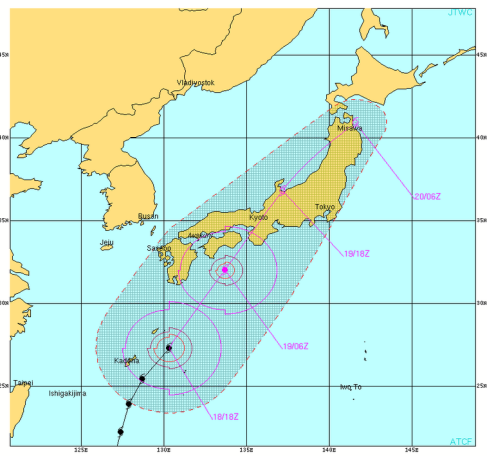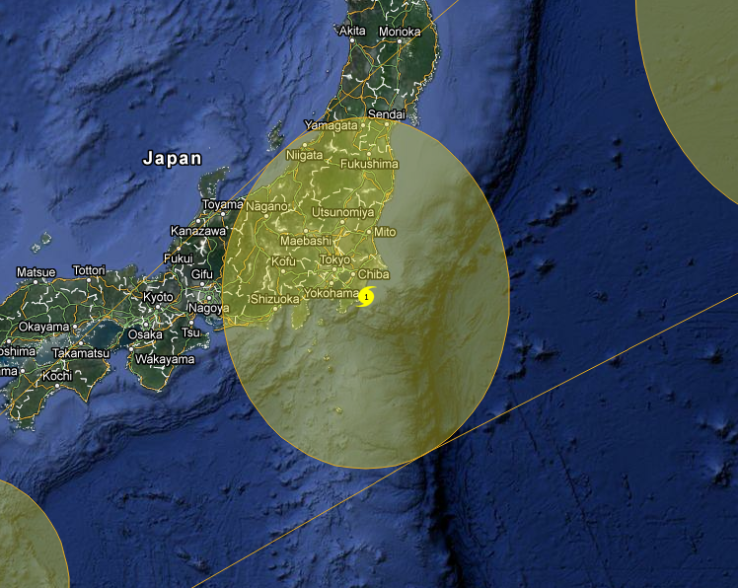
This could be potentially very devastating for the northern hemisphere. Fukushima’s damaged reactor and waste pools are still leaking, if this typhoon hits, most likely it will be damaged further, perhaps destroyed completely, leaking out the rest of the radiactive materials into the air and pacific ocean. Maybe its time to go to the southern hemisphere.
Powerful Typhoon GUCHOL (BUTCHOY) has strengthened rapidly into a dangerous 220-km/hr howler…likely to become the 1st Super Typhoon of 2012. Thick Monsoon Rainclouds approaching Western Luzon including Metro Manila and Mindoro (philippines)
GUCHOL (BUTCHOY) will enhance the Southwest Monsoon (aka. Habagat) across Visayas & Luzon particularly the western sections tonight until Tuesday. Breezy to windy conditions & cloudy skies w/ occasional to widespread rains, thunderstorms & squalls will be expected. The seas along the coastal areas along the West Philippine and Visayan Sea will become moderate to rough & dangerous.
Residents and visitors along the East Coast of the Philippines and the Southern Islands of Japan, particularly Okinawa and Ryukyu should closely monitor the progress of GUCHOL (BUTCHOY).
Do not use this for life or death decision. This advisory is intended for additional information purposes only. Kindly refer to your country’s official weather agency for local warnings, advisories & bulletins.
The following Consequences are identified for a Loss of Spent Fuel Pool Level:
* risk of a fire in fuel pool number 4 is real, and that the risks of contamination are so severe that an international effort is required.
* a nominal release of 10% of the SFP 4 inventory of cesium and strontium would represent 3-10 times the March 2011 release amounts
* Spent fuel pools are not protected in the same way as reactor cores, and the unit 4 building is seriously damaged
* the fuel rods currently produce about one megawatt (MVV) or more of waste energy in the form of heat (1,000,000 Watts!)
* If cooling water for the spent fuel pool is lost – either by collapse of the pool, formation of cracks in the pool, or other factors – a major release of radioactive material could result. Given the large amount of heat generated by the fuel rods, the temperature would rise quickly. These rods are surrounded by zirconium cladding, and at high temperatures, this cladding catalyzes hydrogen production, can generate additional heat, and even explode and burn (NRC, 2006).
* The water surrounding the fuel rods in the spent fuel pools serves two purposes: First, it conducts heat away from the fuel assemblies to avoid overheating. Second, it provides shielding from the extremely high radiation levels near the rods.
* loss of shielding by the cooling water could critically increase radiation levels in the entire Daiichi complex. High radiation is already a serious problem limiting worker and even robot access to the plant to perform repairs and mitigation, and to maintain cooling of the other spent fuel pools and reactors. Thus, a catastrophic failure of the unit 4 spent fuel pool could potentially cascade into additional releases from the other spent fuel pools and reactors.
http://www.typhoon2000.ph/advisory.html
http://thewatchers.adorraeli.com/2012/06/16/typhoon-guchol-intensified-near-philipiness-heading-toward-japan/
http://www.usno.navy.mil/NOOC/nmfc-ph/RSS/jtwc/warnings/wp0512.gif
http://enformable.com/2012/06/nuclear-engineer-identifies-mechanism-for-potential-catastrophic-drain-down-of-fukushima-unit-4-spent-fuel-pool/
June 16, 2012
Categories: apocalypse, fukushima, information, news, weather . Tags: butchoy, disaster, fukushima, Luzon, Metro Manila, Mindoro, Monsoon, news, Nuclear fuel, Philippines, radiation, Spent fuel pool, typhoon guchol . Author: wastingtheendtimes . Comments: 9 Comments




